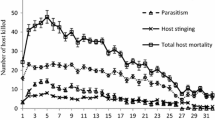Abstract
All life-stages ofSarcoptes scabiei var.canis survive in the hosts' environment for several days to several weeks depending on r.h. and temperature. Survival of larvae was comparable to males; survival of nymphs was comparable to females. Females and nymphs generally survived longer than larvae and males.
Low temperature (10–15°) and high r.h. prolonged survival of all life stages. At 10–15°C, females and nymphs survived 1–3 weeks at 97% r.h., 1–2 weeks at 75% r.h. and 5–8 days at 45% r.h. At 20–25°C, survival was significantly reduced but all life-stages survived at least 2 days at 25% r.h. and 5–6 days at 75–100% r.h. Long survival off the host coupled with host-seeking behavior of these mites make it likely that environmental contamination is a source of scabies in domestic and wild mammals, and in humans.
Similar content being viewed by others
References
Arlian, L.G. and Vyszenski-Moher, D.L., 1988. Life cycle ofSarcoptes scabiei var.canis. J. Parasitol., 74: 427–430.
Arlian, L.G., Runyan, R.A., Achar, S. and Estes, S.A., 1984a. Survival and infestivity ofSarcoptes scabiei var.canis and var.hominis. J. Am. Acad. Dermatol., 11: 210–215.
Arlian, L.G., Runyan, R.A. and Estes, S.A., 1984b. Cross infestivity ofSarcoptes scabiei. J. Am. Acad. Dermatol., 10: 979–986.
Arlian, L.G., Runyan, R.A., Sorlie, L.B. and Estes, S.A., 1984c. Host-seeking behavior ofSarcoptes scabiei. J. Am. Acad. Dermatol., 11: 594–598.
Arlian, L.G., Vyszenski-Moher, D.L. and Cordova, D., 1988a. Host specificity ofS. scabiei var.canis (Acari: Sarcoptidae) and the role of host odor. J. Med. Entomol., 25: 52–56.
Arlian, L.G., Estes, S.A. and Vyszenski-Moher, D.L., 1988b. Prevalence ofSarcoptes scabiei in the homes and nursing homes of scabietic patients. J. Am. Acad. Dermatol., 19: 806–811.
Mellanby, K., Johnson, C.G., Bartley, W.C. and Brown, P., 1942. Experiments on the survival and behavior of the itch mite,Sarcoptes scabiei DeG. var.hominis. Bull. Entomol. Res., 33: 267–271.
Orkin, M., 1971. Resurgence of scabies. J. Am. Med. Assoc., 217: 593–597.
Orkin, M. and Maibach, H., 1978a. This scabies pandemic. N. Engl. J. Med., 298: 496–498.
Orkin, M. and Maibach, H., 1978b. Scabies in children. Symposium on Pediatric Dermatology. Pediatr. Clin. North Am., 25: 371–386.
Parlette, H.L., 1975. Scabietic infestations of man. Cutis 16: 47–52.
Segur, J.B., 1953. Physical properties of glycerol and its solutions. In: C.S. Miner and N.N. Dalton (Editors), Glycerol. Reinhold, New York, 269 pp.
Shaw, P. and Juranek, D., 1976. Recent trends in scabies in the United States. J. Infect. Dis., 134: 414–416.
Witkowski, J.A. and Parish, L.C., 1978. Scabies update 1978. Int. J. Dermatol., 17: 401–402.
Author information
Authors and Affiliations
Rights and permissions
About this article
Cite this article
Arlian, L.G., Vyszenski-Moher, D.L. & Pole, M.J. Survival of adults and developmental stages ofSarcoptes scabiei var.canis when off the host. Exp Appl Acarol 6, 181–187 (1989). https://doi.org/10.1007/BF01193978
Accepted:
Issue Date:
DOI: https://doi.org/10.1007/BF01193978




